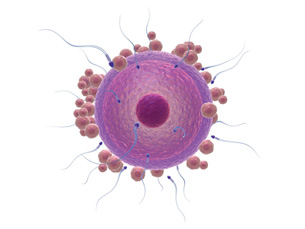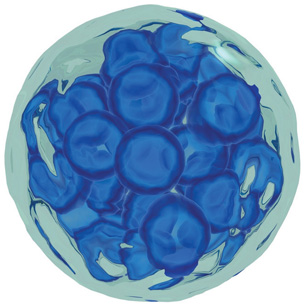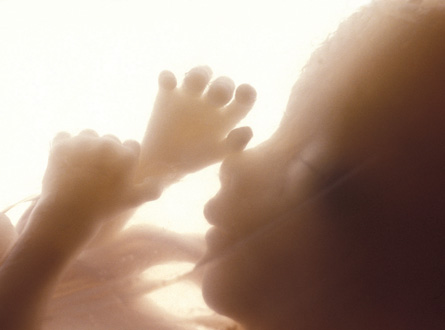Module 4
1. Module 4
1.3. Lesson 1
Module 4—From Fertilization to Birth
Lesson 1—Fertilization and Embryonic Development
 Get Focused
Get Focused
All the structures and functions of mammalian reproductive systems are designed to support the fertilization, implantation, and development of an embryo and, later, fetus. These processes finally result in the continuation of the species through the birth of a new offspring.
fertilization: the fusing of a sperm nucleus with an egg nucleus to form a zygote; occurs in the oviduct
implantation: burrowing of the blastocyst into the wall of the endometrium of the uterus
embryo: the organism in the stages of development from the time the zygote begins cleavage until nine weeks of gestation, when the embryo becomes a fetus
fetus: the organism in the stages of development from nine weeks until birth

© Sebastian Kaulitzki/Shutterstock

© Jenny Horne/Shutterstock

© shahar choen/Shutterstock
How does an offspring go from being a single-cell zygote, which is totally dependent on its mother during its “internal” life in utero, to an organism made up of billions of cells, which is able to survive independently from its mother? The processes that take place from fertilization through to the maturation of the fetus are astounding, and it all starts with just two cells.

© Christian Darkin/shutterstock
Previous lessons introduced the structures and functions of the male and female reproductive systems. You also learned about the hormones that cause the development and the onset of function of these systems. In this lesson you will study the events that occur at fertilization and throughout the eight-week development of the embryo.
Jane and John, whom you met in your introduction to the Fertility Case Study you will be completing throughout this module, were thrilled when they heard the news that they were going to be parents for the first time. They were still thrilled, but a bit surprised, when they discovered they were going to have twins. Imagine how much more surprised they will be when the twins are born with two different skin colours! The probability of this happening is about 1 million to 1. In this lesson you will discover how the different types of twins form and you will be able to explain how giving birth to twins with different skin colours might be possible.
Whether embryos develop as twins or as a single child, their development in the uterus is the same. An offspring’s embryonic development occurs as a vast array of changes beginning with an egg and a sperm uniting in fertilization to form a new individual. Specific names are given to the different stages of embryonic growth and maturation. It should be noted that these various stages of prenatal development contribute to the hormonal control that sustains the pregnancy.
The prenatal development of an offspring is divided into two developmental periods. The first takes place from fertilization to the end of the eighth week of pregnancy. During this period the developing offspring is called an embryo. The second developmental period takes place from the ninth week of pregnancy to birth. During this period the developing offspring is called a fetus.
extra-embryonic membranes: membranes surrounding the embryo, and later the fetus, that support its development in different ways; include the allantois, amnion, chorion, and yolk sac
In addition to the development of the embryo, there are supporting structures that must be formed at the same time. The supporting structures are collectively called the extra-embryonic membranes and they provide the embryo, and later the fetus, with means of nutrition, respiration, excretion, and protection.
Within the first two months of embryonic development, almost all of the organ systems are formed and the embryo begins to appear humanlike. It’s no wonder pregnant women are often very tired in the first few weeks of their pregnancy! All energy and nutritional requirements for prenatal growth come from the mother’s body.

© Stephen Mcsweeny/Shutterstock

© James Blinn /shutterstock

© Tomasz Trojanowski/Shutterstock

© 2008 Jupiterimages Corporation
dizygotic twins: twins that form when two eggs are fertilized by two sperms; also known as fraternal twins; may be of different sexes
monozygotic twins: identical twins formed when the embryonic mass produced by the union of one egg and one sperm splits into two separate, identical masses; are of the same sex
How did Jane and John’s pregnancy result in the formation of twins? There are two ways in which twins can be formed. In a normal sequence of events, a woman releases one egg every menstrual cycle. However, it is not uncommon for two eggs to mature and be released at about the same time in the same ovulation period. If this happens, each egg is fertilized by a different sperm, which results in fraternal (dizygotic) twins. Fraternal twins are not genetically identical and may or may not be of the same sex. During pregnancy and development they each form their own supporting structures, including a placenta. Jane and John had fraternal twins.
The other type of twins is referred to as identical (monozygotic) twins. They are formed from one egg that is fertilized by one sperm. For identical twins to form, the quickly dividing fertilized cell mass separates into two separate cell masses. Since sex is genetically determined from the combination of the parental chromosomes, identical twins are of the same gender. Monozygotic twins may develop their own separate supporting structures or they may share one set.
In this lesson you will examine the following focusing questions:
- What are the sequences of events and hormonal controls that take place throughout fertilization and embryonic development?
- What major tissues and organs arise from the ectoderm, mesoderm, and endoderm?
- How are twins formed?
 Module 4: Lesson 1 Assignment
Module 4: Lesson 1 Assignment
Your teacher-marked Module 4: Lesson 1 Assignment requires you to submit a response to the following:
- Lab—Comparing Embryonic Structures
- Reflect and Connect Questions
Download a copy of the Module 4: Lesson 1 Assignment to your computer now. You will receive further instructions about how to complete this assignment later in the lesson.
The other questions in this lesson are not marked by the teacher; however, you should still answer these questions. The Self-Check and Try This questions are placed in this lesson to help you review important information and build key concepts that may be applied in future lessons.
After a discussion with your teacher, you must decide what to do with the questions that are not part of your assignment. For example, you may decide to submit to your teacher the responses to Try This questions that are not marked. You should record the answers to all the questions in this lesson and place those answers in your course folder.
You will gain information in this lesson that you can use to complete the Unit B Assessment, the Fertility Case Study. Add information to your course folder as you work through the lesson.
While you are completing this lesson, there will be many opportunities for you to acquire, understand, and practise the concepts that are presented to you. As you complete these activities, as well as your summary notes, you will file everything in your course folder to reference when you are preparing for exams.
Remember, you also have the option of trying additional questions from the textbook for further practice. Consult with your teacher for the answers to these questions. The Key will also provide you with many Diploma Exam-style multiple-choice, numerical-response, and written-response questions that will be an excellent review of the module. Practising your responses to these types of questions is good preparation for the Diploma Exam.